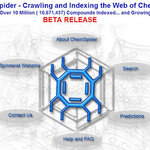Chemistry

When it comes to studying energy transfer in photosynthesis, it's good to think "outside the bun."
That's what Robert Blankenship, Ph.D., professor of biology and chemistry in Arts & Sciences at Washington University in St. Louis, did when he contributed a protein to a study performed by his collaborators at Lawrence Berkeley National Laboratory and the University of California at Berkeley. The protein's moniker? The taco shell protein.
Taco shell protein
It's called bacteriochlorophyl (BChl) a protein, but Blankenship fondly calls it the taco shell protein because of its structure : its…

Freeze-dried ice cream looks like the original product, and even tastes pretty good, but "drying" ice cream at room temperature would leave a sour-smelling, sloppy mess. Similarly, diamonds ejected from deep in the Earth can survive the journey intact only if they head toward the surface quickly and under just the right conditions.
Diamonds, found almost exclusively within kimberlite formations, are stable at great depth and at the planet's surface but rapidly turn to graphite under the high temperature/low pressure condi-tions of most eruptions. A new integrated theory of kimberlite…

Earlier this week, I was contacted by Daniel Zaharevitz, Chief of the Information Technology Branch of the Developmental Therapeutics Program at the National Cancer Institute. He is also involved with the NIH Roadmap Molecular Libraries Initiative. We had a very interesting talk about Open Science and what kind of further impact it could have in drug development. Lets just say that we are on the same page on this issue and I'm really impressed with what Dan is trying to achieve.
The first thing we are going to do is start shipping the compounds we make for an automatic screening of 60 cell…

Use of hydrogen as fuel for vehicles is currently stunted because it is difficult to store in a cost-effective and convenient way. Using metal is too expensive and leads to environmental issues.
Chemists at UC Riverside now offer a possible solution. A class of carbenes – molecules that have unusual, highly reactive carbon atoms – can mimic, to some extent, the behavior of metals, the chemists have found. Called cyclic alkyl amino carbenes or CAACs, these organic molecules, the researchers report, could be used to develop carbon-based systems for storing hydrogen.
In their experiments, the…

Using what is thought to be the world’s smallest pipette, two researchers at the U.S. Department of Energy’s Brookhaven National Laboratory have shown that tiny droplets of liquid metal freeze much differently than their larger counterparts. This study, focused on droplets just a billionth of a trillionth of a liter in size, is published in the April 15, 2007, online edition of Nature Materials.
“Our findings could advance the understanding of the freezing process, or ‘crystallization,’ in many areas of nature and technology,” said Eli Sutter, a scientist at Brookhaven’s Center for…
This week in Science, Yale researchers present “roadmaps” showing that shared protons, a common loose link between two biological molecules, simply vibrate between the molecules as a local oscillator, rather than intimately entangling with the molecular vibrations of the attached molecules.
Led by Professor Mark A. Johnson in the Department of Chemistry, the new data reveal distinct, isolated vibrational patterns, solely associated with the bridging proton, that change dramatically according to the chemical properties of the tethered molecules.
Two oxygen atoms on different molecules are…

Small, clever process technology is essential for the future, but is it possible? Dutch-sponsored researcher Fernando Benito López investigated the possibilities of the so-called lab-on-a-chip: microreactor chips in which chemical reactions can take place under (high) pressure. The results were very promising. The reaction rate increased compared to conventional equipment, the measurements were accurate and safety was not a problem. Moreover it was possible to follow and regulate the reaction during the process.
Benito López started on this project by making microreactor chips that could…
Thanks to Joanna Scott, we've been taking advantage of our invitation to contribute to the Nature island on Second Life. Beth made a copy of the Open Notebook Science building and created a cemetery filled with blue obelisks so that multiple students can take organic chemistry quizzes at the same time. I'll be testing that shortly in my class to see how many students can comfortably compete in a virtual race.
Today I met Andrew Lang (Hiro Sheridan on SL) who has built a molecule rezzer on Nature Island. He has a nice little area where he displays some molecules (like cholesterol) and gives…
Previously, only amorphous polymer materials approached such levels of performance. On the other hand, these “gigantic respiration” and their respiration, which takes place at constant overall shape, is reversible. This discovery, of interest for numerous industrial applications, is published in the journal Science on March 30, 2007.
Structure of chromium (III) diphenyl dicarboxylate, one of the gigantic respiration crystalline solids, in its crude form following synthesis (middle), with all traces of solvent removed (on the left), and after absorption of solvent and increase in volume (on…

There is a new kid on the cheminformatics block.
ChemSpider Beta went live on Saturday March 24, 2007 with over 10 million compounds. Anyone using other free online molecular databases (like eMolecules or Chemistry Search Lookup Service) should definitely give this one a spin.
At this time, it is possible to use the system not only to find molecules in databases but also to predict molecular properties (like density and boiling point), which can come very handy.
But the best reason for keeping an eye on this one is that it is led by Tony Williams. I have known Tony since my graduate…